Snapdragon 800 (MSM8974) Performance Preview: Qualcomm Mobile Development Tablet Tested
by Brian Klug on June 18, 2013 8:00 PM EST3DMark
3DMark for Android features the Ice Storm benchmark and uses OpenGL ES 2.0. Ice Storm is divided into two graphics tests and a physics test. The first graphics test is geometry heavy while the second test is more pixel shader intensive. The physics test, as you might guess, is CPU bound and multithreaded. The overall score takes into account both graphics and physics tests. The benchmark is rendered to an offscreen buffer at 720p/1080p and then scaled up to the native resolution of the device being tested. This is a very similar approach we've seen by game developers to avoid rendering at native resolution on some of the ultra high resolution tablets. The beauty of 3DMark's approach here is the fact that all results are comparable, regardless of a device's native resolution. The downside is we don't get a good idea of how some of the ultra high resolution tablets would behave with these workloads running at their native (> 1080p) resolutions.
For these benchmarks we stuck with the default presets (720p, normal quality).
Here the key comparisons are against the Adreno 320 based HTC One/SGS4 (T-Mobile) and the PowerVR SGX 544MP3 based SGS4 (SHEVE300S). The Nexus 10 is interesting but pretty much a blowout. Snapdragon 800 is clearly the new high-end Android tablet SoC of choice.
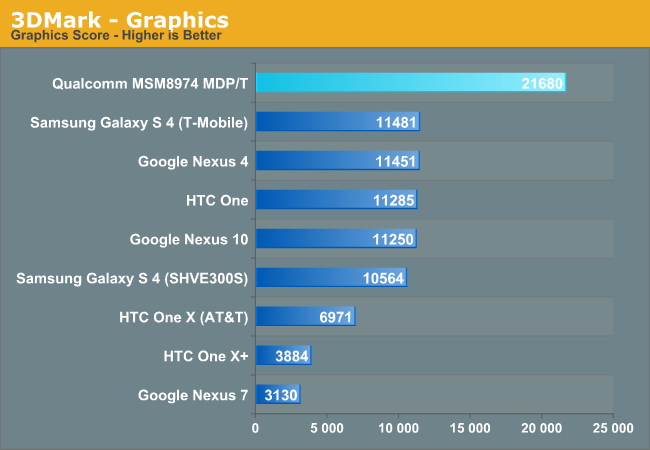
The overall graphics score from Adreno is amazing. We're looking at almost 2x the next fastest contender here, the Adreno 320 based Snapdragon 600.
Graphics Test 1
Ice Storm Graphics test 1 stresses the hardware’s ability to process lots of vertices while keeping the pixel load relatively light. Hardware on this level may have dedicated capacity for separate vertex and pixel processing. Stressing both capacities individually reveals the hardware’s limitations in both aspects.
In an average frame, 530,000 vertices are processed leading to 180,000 triangles rasterized either to the shadow map or to the screen. At the same time, 4.7 million pixels are processed per frame.
Pixel load is kept low by excluding expensive post processing steps, and by not rendering particle effects.

Graphics Test 2
Graphics test 2 stresses the hardware’s ability to process lots of pixels. It tests the ability to read textures, do per pixel computations and write to render targets.
On average, 12.6 million pixels are processed per frame. The additional pixel processing compared to Graphics test 1 comes from including particles and post processing effects such as bloom, streaks and motion blur.
In each frame, an average 75,000 vertices are processed. This number is considerably lower than in Graphics test 1 because shadows are not drawn and the processed geometry has a lower number of polygons.
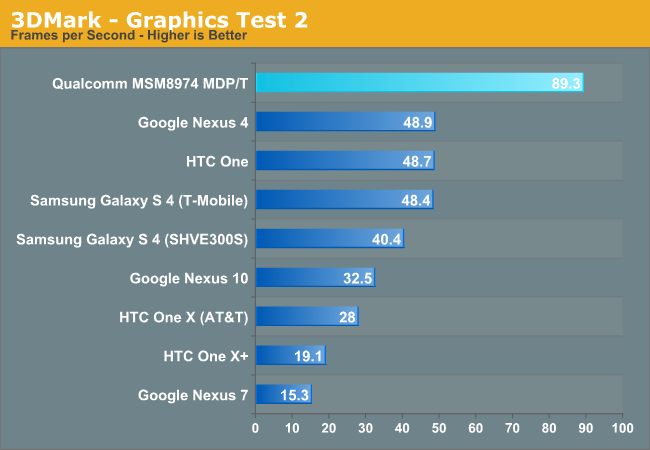
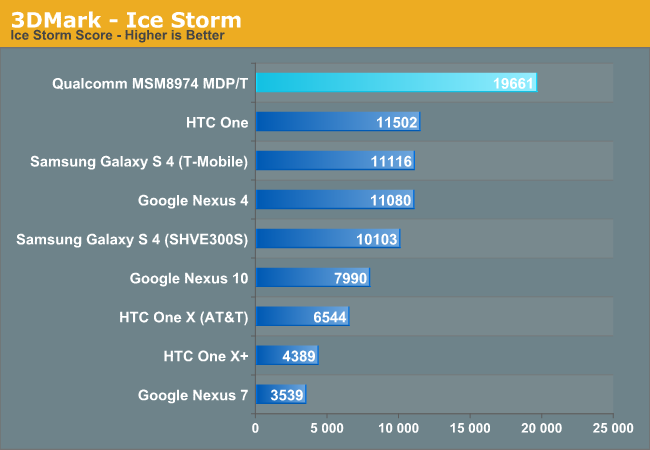
The overall Ice Storm score shows a 71% improvement over Snapdragon 600, which is the closest competitor.
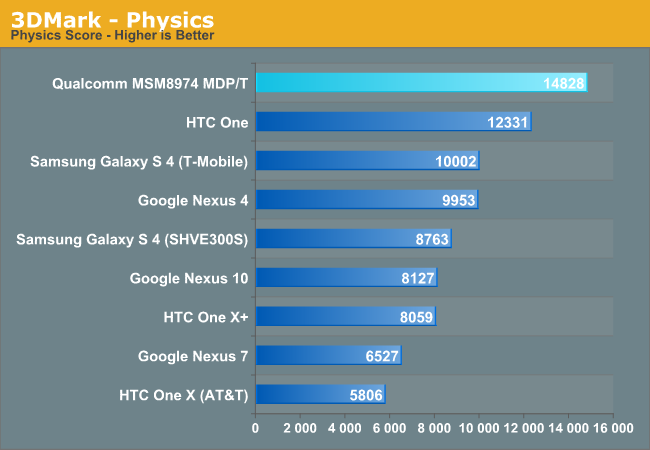
The physics test takes multicore CPU performance into account, but even then the Snapdragon 800 remains ahead of the pack. The performance advantage over the lower clocked Snapdragon 600 shrinks to just 20%, which is a bit lower than clock speeds alone would normally tell us.
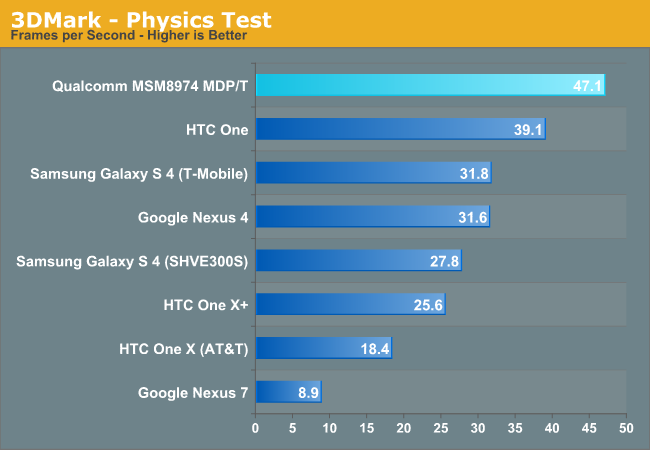










115 Comments
View All Comments
shodanshok - Sunday, June 23, 2013 - link
You are right :) The 2 GHz / 2 Watt rating was at 40nm. It was explicity called at ARM site, so I didn't specified that above.Anyway, lacking NEON instructions means nothing for CoreBech, as it don't test vector code.
Regards.
Wilco1 - Sunday, June 23, 2013 - link
Coremark can be vectorized, which one reason why the scores have improved. Tegra 2 was terrible in most respects, Exynos 4 and Calxeda are currently the best A9 implementations until Tegra 4i is released. Obviously it will be very interesting to see how Silvermont will do against Tegra 4i.Wilco1 - Sunday, June 23, 2013 - link
Now we've agreed that A9 can reach similar frequencies then we can normalize on frequency, yes? When you normalize on frequency then in-order vs OoO matters more, which is what I said all along.1. NVidia has shown their 2.3GHz Tegra 4i reference phone which should be on the market soon. The reason you don't see 2GHz A9 phones today is (a) use of older processes and (b) use of quad cores which leads to too much power use at high frequencies. If they were single or dual core then it would be easier to go for 2GHz.
2. Atom only supports dual core (even Centerton is dual core trying to compete with the Calxeda quad core...), and until the recently released K900 I believe all Atom phones were single core. On the other hand most smart phones have been quad-core since 2012.
3. I still don't see where you think that A9 is slower per core than Atom. At the same frequency it is unbeaten even if you give Atom the advantage of Hyperthreading.
4. If you say that a core with HT is just a single core then surely it should look like a single core to software as well and provide a speedup to single-threaded applications? As soon as you enable HT for a multithreaded application then it would be unfair to compare with single threaded performance on a non-HT core. You can't just pick and choose a comparison that gives one core a major advantage over another.
So far I haven't seen any evidence of native benchmarks where Atom is clearly faster. If you do a fair like for like comparison then A9 wins every time. However if you remove the advantages from one core but keep all the advantages for another then you can of course prove whatever you like.
shodanshok - Sunday, June 23, 2013 - link
1) During Atom lifetime as competent product (read: before A15 release), _no_ phone (or tables, to best of my knowledge) shipped with A9 faster then 1/1.2 GHz. Even Scorpion based phones had higher frequencies. Anyway, from the Coremark comparison written above, you can see that normalizing core/frequency lead to similar per-core performance between A9 and Atom. With the difference that Atom shipped at generally higher frequency, even @ 2.0 GHz: http://www.anandtech.com/show/6307/motorola-hits-2...Comparing a 5-year-old Atom to a to-be-shipped Tegra 4i which as tweaked cores seems fair? I think no.
2) For scaling above 2 cores, currently Atom use FSB communication. However, I can not see why you need 4 Atom cores in a phone. Anyway, you have a point here (on-chip communication are much more pratical) ;)
3) HT is a simple, cheap method to increase total tput. You can not consider an HT-enabled Atom as having 2 cores. Even on coremark sites an HT-enabled Atom is considered a one-core processor. I reiterate: how to consider a barrel processor? A many core approach?
4) You can find many benchmark were Atom excels... some example:
a) http://www.anandtech.com/show/5770/lava-xolo-x900-... (OS android - browser benchmark + linpack + other)
b) http://www.anandtech.com/show/6529/busting-the-x86... (OS WinRT / Win8 - many web brower benchmark)
You can not mark all web browser benchmark as "flawed". Sure they are not 100% uarch dependant, but they are a good method to evaluate the entire software stack used by these processors.
Regards.
Wilco1 - Sunday, June 23, 2013 - link
1. Not true - A9 was running at 1.4GHz in 2011 products, 1.5GHz early 2012 and 1.7GHz late 2012. So A9 was most definitely available at higher frequencies, including in phones (One X). With the shrink to 28nm it gets another boost to 2.3GHz. So in frequency it can match or beat Atom (note by the time it comes out, it'll be compared with Silvermont which achieves similar frequencies).3. Yes a barrel processor looks and behaves like multiple slow cores. The fact that they share hardware in a very specific way is an implementation detail. An equivalent approach would be multiple independent cores. Do you consider a Bulldozer module as a single core as well?
If you prefer to just compare a single core then you should only consider its single threaded performance. As soon as you compare multithreaded performance, then it is completely fair to allow each CPU designer to decide how to implement that, whether it is with HT/SMT, multiple cores or AMD's inbetween approach. You're right of course that HT is a fairly cheap way of adding more threads if you already have a complex core - using multiple cores is only a good idea if you designed your core to be as small as possible.
4. Anand is the worst place to look for CPU benchmarks. Most are JavaScript benchmarks which can vary by a factor of 2 even on the same browser. And his Linpack test is more a Dalvik test than about FP performance. Although there are cases where performance of a browser is important (things like rendering pages), we are discussing micro architecture performance, not how the Android software stack performs.
shodanshok - Monday, June 24, 2013 - link
1) Almost all widespread phone had A9 running at 1.0/1.2 Ghz for so much time. Only recently they increased their frequency at about 1.4 Ghz, and atom is @ 2.0 GHz now.2) "Look as" is not the same as "it is". So a T2 is the equivalent of a 128 core machine? Really? You are confusing SMP with SMT. Look at coremark results: a quad core A9 has performance 4x of a single core, and the score/core reflect this (it is the total score divided by 4). Quad thread Atom instead is a two core uarch, only slightly (30%) faster when tested with 4 thread instead of 2. In fact, coremark/core score is obtained dividing the total score by two, even if the test run with 4 threads. Even coremark developers are wrong?
3) All the posted benchmark,with the exception of Geekbench, show how Atom single core performance are better then A9. Yet you refuse to look at the data, dismissing them as "flawed" or inappropriate. Even user experience, in your eyes, does not matter. can you point us to some reliable bench?
Regards.
darkich - Thursday, July 4, 2013 - link
I think Wilco gave up on discussing with you since you just proved your huge ignorance (the A9 clock speed) and are even trying to defend it.When was the One X + released?
What about the Tansformer prime infinity?
darkich - Thursday, July 4, 2013 - link
I think Wilco gave up on discussing with you since you just proved your huge ignorance (the A9 clock speed) and are even trying to defend it.When was the One X + released?
What about the Tansformer prime infinity?
kukzero - Friday, June 21, 2013 - link
absolutely impossible! The 7900GTX can run Crysis in 720p (30fps),but the Snapdragon 800 can run it? hehe wqnmlgbemperius - Friday, June 21, 2013 - link
Wow. Imagine this paired with Sony and Nexus!? YES